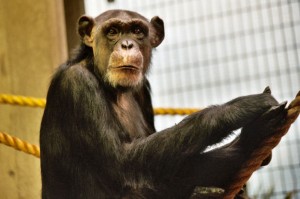 Fresh findings in the field of genetics have directly challenged yet another key evolutionary hypothesis by showing that the differences between humans and apes cannot be easily accounted for under the theory of evolution.
Fresh findings in the field of genetics have directly challenged yet another key evolutionary hypothesis by showing that the differences between humans and apes cannot be easily accounted for under the theory of evolution.
A recent 12-page journal article, written by three scientists in Spain and published in Molecular Biology and Evolution, details the results of careful analysis of human and chimpanzee DNA. After comparing and contrasting thousands of orthologous genes from humans and chimps, the scientists found their final data to be very much at odds with evolutionary theory. In fact, they even titled their article “Recombination Rates and Genomic Shuffling in Human and Chimpanzee—A New Twist in the Chromosomal Speciation Theory.”
Why are these findings seen as a “new twist” to the evolutionary theory? In short, because many scientists have claimed that genetic differences between humans and apes can be attributed to a process known as “genetic recombination,” which is a phenomenon that generates slight genetic variation via meiosis. However, this new journal article seriously calls this proposition into question.
In their research, the three Spanish scientists scrutinized differences between human and chimp genes, expecting to find higher genetic recombination rates in these areas of dissimilarity. Even though studies of human-chimp similarities have been conducted in years past, this particular research was unprecedented because the scientists took advantage of new, high-resolution genome maps.
Ultimately, the study results were contradictory to what evolutionists had theorized. Not only were genetic recombination rates markedly low in areas of human-chimp DNA differences (“rearranged” chromosomes), but the rates were much higher in areas of genetic similarity (“collinear” chromosomes). This is the reverse of what evolutionists had predicted.
“The analysis of the most recent human and chimpanzee recombination maps inferred from genome-wide single-nucleotide polymorphism data,” the scientists explained, “revealed that the standardized recombination rate was significantly lower in rearranged than in collinear chromosomes.”
Jeffrey Tomkins, a Ph.D. geneticist with the Institute for Creation Research (ICR), told the Christian News Network that these results were “totally backwards” from what evolutionists had predicted, since genetic recombination is “not occurring where it’s supposed to” under current evolutionary theory.
Dr. Tomkins further emphasized that evolutionists greatly exaggerate the genetic similarities between humans and chimps, and often ignore areas of DNA where major differences do exist.
“It’s called cherry-picking the data,” he explained. “There are many genetic regions between humans and chimps that are radically different. In fact, humans have many sections of DNA that are missing in chimps and vice versa. Recent research is now showing that the genomes are only 70% similar overall.”
This is not the first time scientists have questioned evolutionists’ assertions regarding humans’ and chimps’ similarities. David DeWitt, a biochemist and Ph.D. neuroscientist, reiterated in an article for Answers in Genesis that evolutionary scientists commonly underestimate the genetic dissimilarities between humans and apes by significant margins. And even relatively small percentage differences equate to formidable genetic discrepancies.
“If 5% of the DNA [between humans and apes] is different,” Dr. DeWitt points out, “this amounts to 150,000,000 DNA base pairs that are different between them!”
Ultimately, Dr. Tomkins concluded, genetic evidence is once again stacking up against evolutionary scientists, forcing them to revise their theories.
“Evolutionists are having a lot of problems dealing with current studies in DNA research,” he stated. “Their predictions based on their naturalistic presuppositions are consistently being overturned by scientific discovery. Because they cannot accept the idea of a Creator, they simply change their theory to adapt. The only thing that appears to be evolving is ‘evolution,’ and it’s becoming more and more absurd.”
Become a Christian News Network Supporter...


